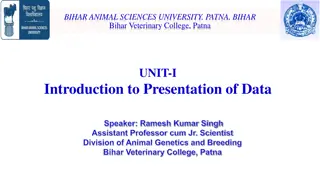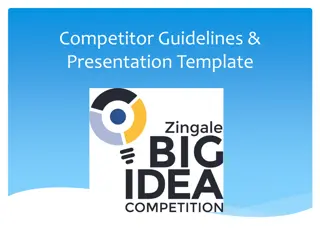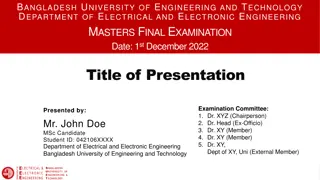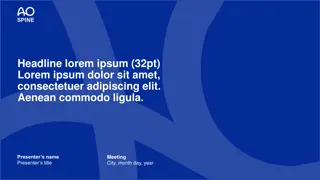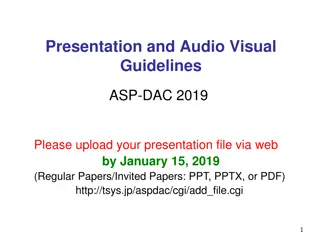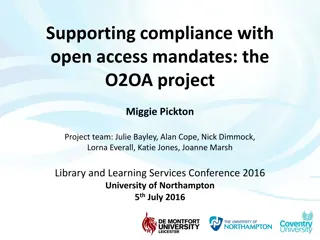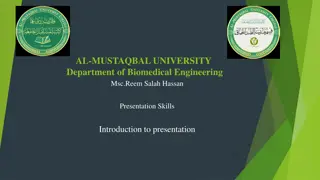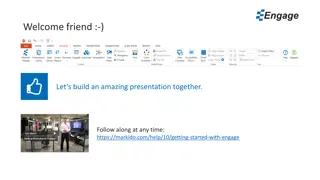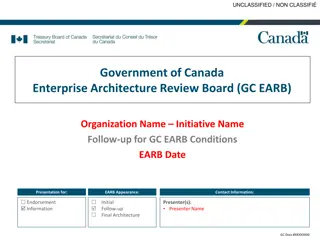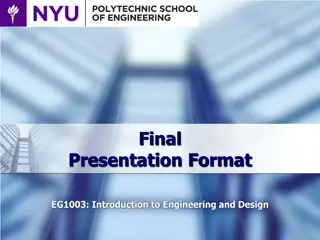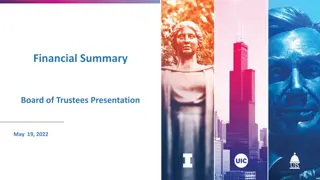
New Applications of CLA+: Assessing Critical Thinking Skills
Explore the evolution and impact of the CLA+ assessment tool, designed to measure critical thinking skills in higher education. Discover its origins, purposes, test features, sample performance tasks, and the benefits of performance assessment in predicting student success.
Download Presentation

Please find below an Image/Link to download the presentation.
The content on the website is provided AS IS for your information and personal use only. It may not be sold, licensed, or shared on other websites without obtaining consent from the author. If you encounter any issues during the download, it is possible that the publisher has removed the file from their server.
You are allowed to download the files provided on this website for personal or commercial use, subject to the condition that they are used lawfully. All files are the property of their respective owners.
The content on the website is provided AS IS for your information and personal use only. It may not be sold, licensed, or shared on other websites without obtaining consent from the author.
E N D
Presentation Transcript
Current and New Applications of CLA+ Roger Benjamin CAE HEFCE Conference London February 9, 2015
Themes Origin and evolution of the CLA Value Added protocol Meeting new challenges: CLA+ Career Connect Observations about adapting standardized assessments in the United Kingdom
History Matters, 1999-2004 Measurement scientists and education policy specialists at RAND launch new approach to standardized assessment in post-secondary education. Goals and Premises of the group, Focus on improvement Maintain high measurement science standards Gain initial funding from foundations
Purposes of CLA+ Measures critical thinking skills faculty/employers emphasize Analysis and problem solving Scientific and quantitative reasoning Critical reading and evaluation Critique and argument Writing mechanics, writing effectiveness Provides within and across institutional benchmarks for measuring improvement Influences curriculum and instruction Provides test results, normed and criterion referenced for individual students
CLA + 90 minute Test Features Performance tasks, direct measures of critical- thinking, require open-ended, constructed responses Selective Response Questions require critical thinking skills The student and the school are the units of analysis Control for input (ACT/SAT scores or other proxy) Internet-based test for administration, scoring, and reporting Computer assisted scoring Use engaging cases and problems that assess an integrated combination of skills based on a variety of topics from arts and sciences. Document library provides all the information needed for the student.
Sample Performance Tasks Lionfish More memory Life expectancy Myth of Icarus Museum Literacy Organization Humanities Lake-to-River Social media Crime reduction Voting age Science Science Science Humanities Humanities Social sciences Social science Public policy Public policy
Case for Performance Assessment Performance assessments predict college freshmen success as well as the SAT or ACT. Performance assessments therefore become highly desirable because, Such tests illustrate the desired coherence between instruction, assessment, and the complex challenges students face in the classroom and beyond. They are superior to multiple choice tests that only predict success. Class time spent on teaching students how to apply knowledge and skills to real-world problems is time well spent. Teach-to-test should therefore be encouraged for performance assessments which are based on real world problems or cases to analyze.
Is Critical Thinking Independent From Academic Disciplines? Critical-thinking skills are situated between Spearman s G---a single undifferentiated general intelligence and differing and independent kinds of intelligence (Gardner). Critical-thinking skills are broad abilities that are applicable across an array of academic disciplines or domains.
Are Interaction Effects With disciplines Inevitable? The Chemistry Flame Test Students are evaluated on whether they can figure out the chemical composition of an unknown substance by its response to a flame test But also on the appropriateness of the tests they ran, the sequence of those tests, and the rationale for their conclusions This test requires substantive and procedural knowledge but it also assesses generic problem- solving and reasoning skills.
The Value Added Approach Provides an estimate of a school s contribution to student learning after controlling for input based on a matrix sampling design. Involves computing whether a school s mean CLA score is higher or lower than what would be expected given (a) its mean SAT/ACT score and (b) the typical relationship between mean CLA and SAT/ACT scores among all the schools in the program. Facilitates measuring and interpreting the progress a school s students made relative to students at similarly situated colleges.
Critics: Attrition and Motivation Effects Negates Value Added Growth Claims Students entering academic ability (EAA) scores are made up of their SAT/ACT math and critical reading scores. The difference in the EAA scores between freshmen and senior cohorts is 20 points, less than a 2% difference. This is not enough to explain a mean .73 effect size value added score (equating to 19% variance) across 1,400 institutions testing over 8 years.
Value Added Results for Colleges Testing 2009-12 2009-12, n=481 30 25 20 Frequency 15 10 5 0 -3.0 -2.5 -2.0 -1.5 -1.0 -0.5 0.0 0.5 1.0 1.5 2.0 2.5 3.0 Value-Added Scores
The Case for Comparisons Most colleges as well as faculty and employers commit to improving critical-thinking skills. Without comparisons based on appropriate standardized tests, institutions (and countries) are isolated one from another with no basis to know how well they are doing. International comparisons are challenging but appear to be promising.
Other Questions Will CLA+ not create a teach-to-the-test environment? Is not CLA+ reductive in nature just like other such tests? How are the testing results used?
Where We Stand Today Measurement science community (TVS study) agrees that critical thinking is real, important, can be improved, and can be measured in a reliable and valid way. The Dep. of Education funded 21stcentury test program (2012) is leading to new assessment paradigms beyond multiple choice tests. Computer-assisted scoring creates new assessment opportunities for performance-based assessment in the classroom. Methodological innovations such as propensity matching analysis make international comparisons promising.
Strengthening the Value Added Approach Many colleges find the value added approach useful for internal improvement and accountability, however, assessment not yet viewed as essential to post-secondary education, Students are neither required to take the test or try hard on it if they do. Professors do not have clear incentives to improve the critical-thinking skills of their students Colleges are not asked to demonstrate they produce students with the critical-thinking skills employers say are requisites for work success.
The Solution The value added no stakes focus on improvement needs to be integrated with a CLA+ test focused on a problem of sufficient stakes that is compelling to students, professors, employers and colleges. If this step is accomplished, stronger incentives to focus on improvement of teaching and learning assisted by formative and standardized assessment will exist at all levels of post- secondary education.
The Problem To Focus On: College To Career Two problems, combine, to warrant CLA+ focus with stakes attached, The imperative to improve human capital, the principal resource any nation has, through the post-secondary system. The need to provide equal opportunity for all college graduates to compete on a level playing field for jobs they are qualified for.
The Major Policy Challenge A small set of selective colleges form a positional good that blunts the opportunities of too many high ability college seniors in less selective colleges to obtain high value added jobs. The result is a mal-distribution of human capital at the national level and an unequal playing field for too many high ability students who graduate from less selective colleges.
A Market Failure in the Graduating Seniors to Career Space They are impediments that impede the efficiency and effectiveness of buyer (employer) and seller (graduating college senior) exchanges. In this case, Because of grade inflation, the cumulative national mean senior GPA is 3.3 on a 4.0 scale. Employers do not have the information they need to decide which applicants to interview. Too many students do not get a chance to interview with appropriate potential employers. Colleges do not know which skills employers are looking for or what skills they should inform employers they should evaluate.
Table 1 Colleges & Universities 1980 Student Enrollment 1980 2012 2012 Selective Less Selective 143 (5%) 3,014 (95%) 143 (5%) 3,014 (95%) 762,248 (12%) 5,584,841 (88%) 940,771 (9%) 9,823,718 (91%) ALL 3,157 (100%) 3,157 (100%) 6,347,089 (100%) 10,764,489 (100%)
Graph 1 Projected National CLA+ Performance
Geographic Distribution of Institutions, by Selectivity
Selective Colleges Are Isolated From Most Students The 143 selective colleges, largely in the North East, form a positional good gatekeeper system that overly determines the life chances of all college graduates in the United States. The location of the selective colleges means there is a geographic disconnect with large and growing ethnic/racial groups throughout the United States.
Work Readiness Assessments Are focused on Human Resource office requirements and are comprised of one or more of the following, Personality measures, e g., extrovert/introvert, degree of teamwork, persistence, well being Academic discipline tests, Content/knowledge Aptitude tests, prediction of ability of candidate to succeed in specific fields---Work Keys Ability tests, hard and soft cognitive measures
Evaluation of Work Readiness Tests Suggests Significant Problems The criteria to evaluate assessments are reliability, validity, time, and cost. There is no consensus about ability of work readiness tests, alone or in combination, to meet the evaluation criteria. Moreover, work readiness tests do not deal directly with the market failure issue.
The CLA+ Career Connect Premise Career connect is designed as a pre-screening tool between college and career, upstream from Human Resource offices. This is the major part of the market failure problem. Department of Labor OBON data base demonstrates hundreds of fields require critical thinking skills measured by CLA+. The CLA+ and its career connect system meets Occam s Razor requirements---metrics should deal with the most significant problem and not be multiplied unnecessarily to cover it. Therefore, offer CLA+ Career Connect to graduating seniors Use Career Connect system to bring employers and students together
What Is The CLA+ Career Connect System? Badges for students who take CLA+ and score in top 50%---proficient, accomplished, advanced. Students can take CLA+ through their institutions or alone. Qualifying students will be able share CLA+ scores directly on employment boards. Virtual career fair that brings employers and badged students together . Employers chose students they wish to continue the potential employment process with.
Applications of CLA+ Career Connect National U.S. Pilot May 2014 results, Eight percent of the 20,000 testing seniors scored in the advanced levels Employer Fortune 500 group found 20 percent of members of this group who attended a virtual career fair acceptable to hire and indicated they would participate in Career Connect again Two regional applications underway in Texas Italian Teco (CLA+) with Career Connect underway for this spring
Implications In U.S. current positional good-based system led by selective colleges (founded before 1900) in U.S. is no longer sustainable. The population has grown from 75 million in 1900 to over 320 million in 2014 and will increase to over 400 million over the next several decades. Countries in the European Union and elsewhere may face similar market failures with different characteristics.
Three Factors Create Need For Standardized Assessments Recognition of the centrality of human capital will translate into more demands for oversight The cost-disease problem, combined with declining public resources, presents the need for metrics to evaluate quality of outcomes. The drive for equal opportunity will accelerate the use of objective measures of student learning outcomes graduating seniors can use.
The Principal Goal Is to make assessment, formative and standardized, essential to teaching and learning. When this is accomplished, we will have taken a significant step toward a continuous system of improvement of undergraduate education analogous to the peer review based continuous system of improvement that drives research.
Challenges of Adapting U.S.-Based Standardized Assessments to UK Translation and adaptation of assessment items required if international comparisons desired. Value added approach possible but A Levels provide different starting point and typical undergraduate program is three not four years. Equating, standard setting methods useful. For value added approach no tests like SAT to use to adjust for entering abilities? Propensity matching analysis is a possibility.
References See R. Benjamin et al., (2013), The Case for Critical Thinking Skills and Performance Assessment at cae.org for review of reliability and validity studies of CLA. For sample performance tasks and selective response tests see http://cae.org/images/uploads/pdf/CLA_Plus_Pr actice_PT.pdf and http://cae.org/images/uploads/pdf/CLA_Student _Guide_Institution.pdf




